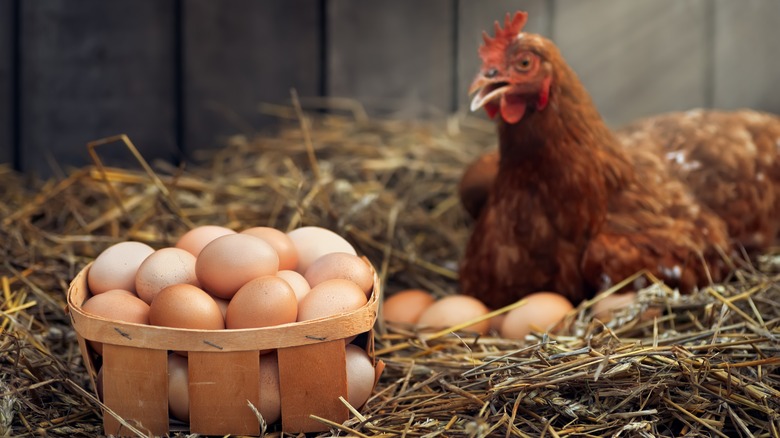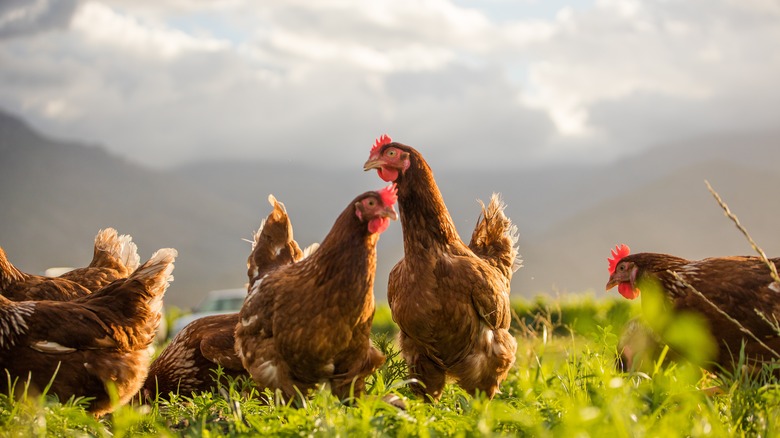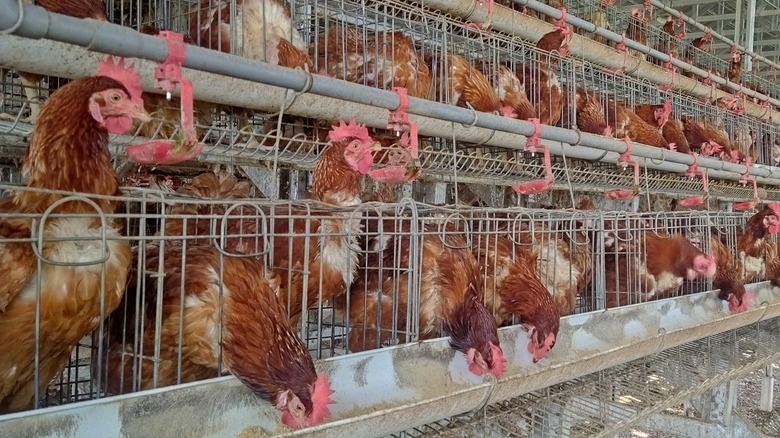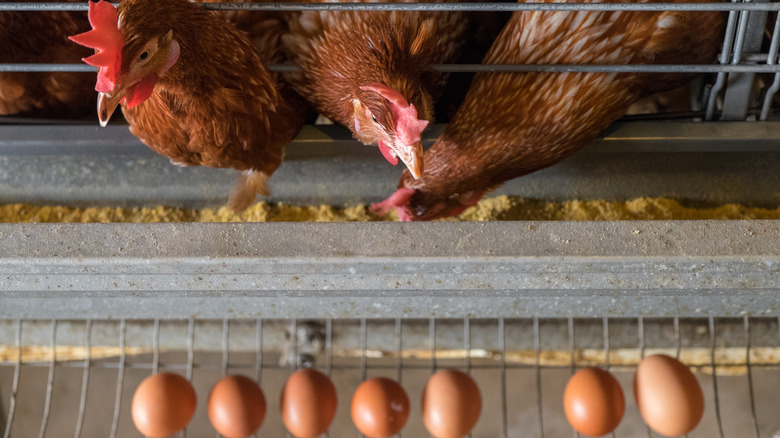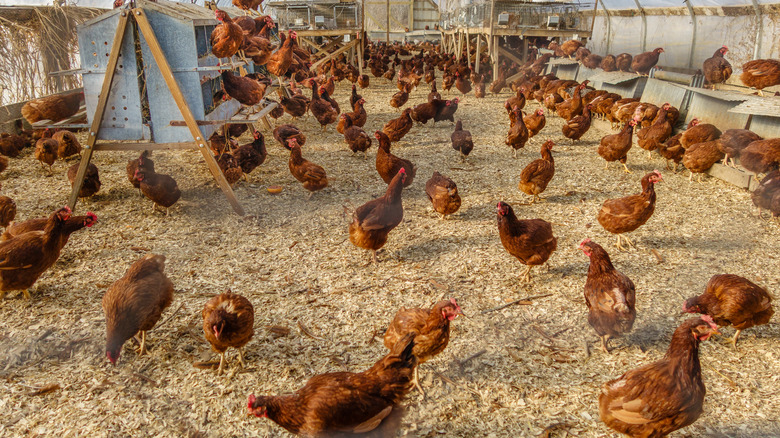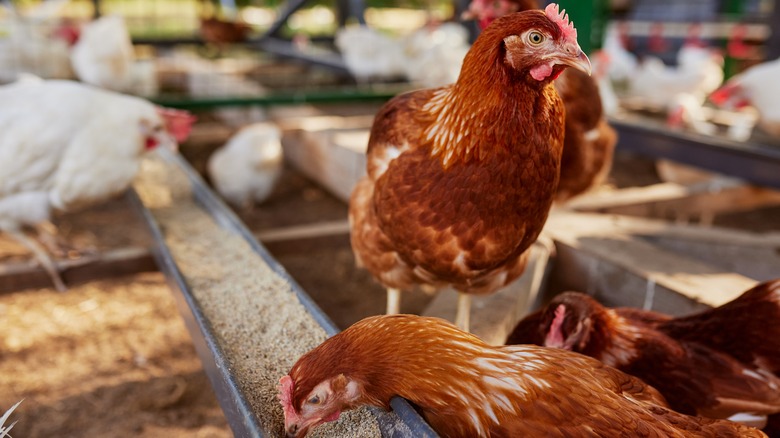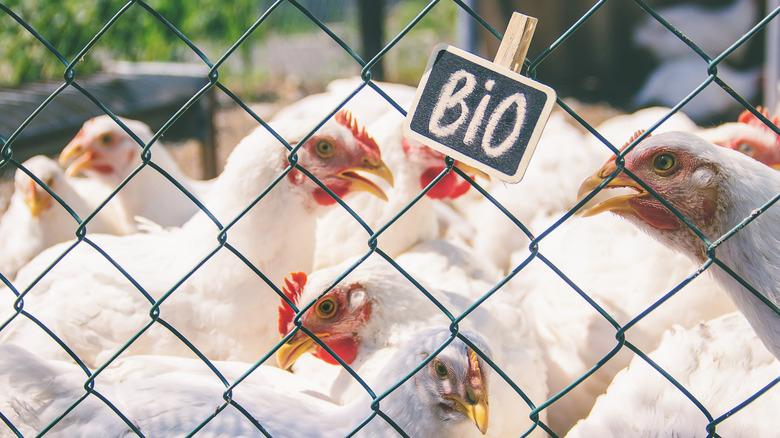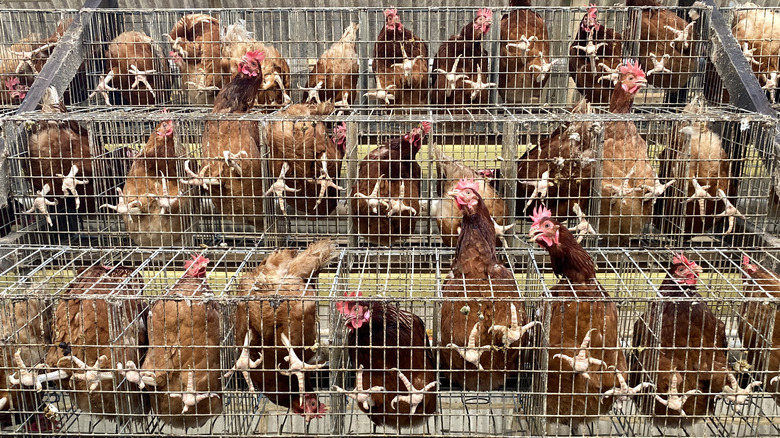Cage-Free Eggs Vs. Conventional Eggs: Everything You Need To Know
Which came first, the chicken or the industrial commercial egg farm? Raising backyard chickens for meat and eggs has been the practice of humans as long as the little dinosaurs were able to be caught and tamed, but it wasn't until 1926 that Wilmer Steele of Sussex, Delaware, built what is recognized as the first commercial chicken farm, raising 10,000 birds for meat in a single building. In the 1940s, commercial egg production began to explode, with thousands of chickens moving from small coops in backyards to large buildings with carefully regulated systems to maximize egg production and minimize expense. China produces the most eggs through commercial egg farms globally — about 40% of global egg production. Today, the refrigerated egg section of your local supermarket is as confusing as it has ever been. Different labels, advertised production methods, and a wealth of consumer misinformation can make it difficult to select eggs.
Cage-free and conventional eggs are the most prevalent types of eggs available in the market, each with its own characteristics and production methods. Ignoring the popular myths about the nutritional content of cage-free versus conventionally raised eggs, the major thing to consider is how you feel about the chickens themselves. Talking about cage-free vs conventional eggs means discussing how the eggs are produced. When the welfare of the creatures that produce your food matters to you, there is a clearly better option (cage-free eggs for the win); here's what you need to know about cage-free vs conventional eggs.
What are cage-free eggs?
The simplest definition of cage-free eggs is that the chickens that lay them live in an open indoor space. Cage-free facilities can range in size from a small flock of 100 birds to larger production facilities with thousands of birds in the same space. In a cage-free setting, chickens are fed and watered in communal spaces. They are also generally housed on footing that feels more natural; sawdust, gravel, and dirt are usually found underfoot.
Most people see cage-free eggs as a more humane egg production method, but tremendous variation is possible. The number of chickens certainly affects their quality of life on the farm, and the actual facility — the barn or building in which they are housed — can vary dramatically. Most buildings on large cage-free egg production farms do not have windows, and the lights are timed to increase egg production rather than give chickens a more natural experience of seasonal cycles.
Even with the shortcomings and variations in capacity and housing conditions, eggs produced by chickens in cage-free facilities are generally considered more humane. The ability to move around and stretch is important for the mental and physical health of the birds, and some facilities even provide opportunities to participate in more natural behaviors like dust bathing.
What are conventional eggs?
Conventional eggs make up the vast majority of the egg market in the United States. This system was developed to increase the number of eggs, focusing on producing a high volume in short periods. The results of this push for more and faster production come at the price of the chickens' welfare.
Chickens in industrial egg production facilities live in exceedingly cramped quarters. They are housed in battery cages, small wire boxes that are 15 inches tall. Standards set by the United Egg Producers require a minimum of 67 square inches of space per bird. For some perspective, this is about the same size as a sheet of notebook paper. Each cage contains up to ten laying chickens, with cages stacked. The floor of the cage is wire, and chickens often experience cuts and damage to the feet, with so much pain that many stop standing. Food is delivered in a trough at the front of the cages, and no water is provided. Eggs roll out the bottom of the cage and are picked up in the front.
Many industrial egg farmers and the companies that supply them tout the decreased waste and increased egg production possible with conventional egg farming practices. They also point out a lower incidence of disease, as contact between chickens and humans is minimal. However, many opponents of this practice point out overcrowding and the physical and mental distress that make this a less-than-ideal setup for the chickens.
Egg production set-ups can be confining
When only cage-free or conventionally farmed eggs are available, cage-free eggs are often seen as the better choice. After all, chickens are not stacked in wire boxes with up to nine other creatures. They are free to move about and may also have access to perches and nesting boxes. But take a closer look. Even cage-free production can be confining. Some facilities only budget two square feet per bird, which means that overcrowding is often an issue.
Comparing those two feet to conventionally farmed eggs makes it seem like a mansion for each chicken, though. Battery cages provide the minimal amount of space required per bird, with each chicken allotted a notebook paper-sized area to live their life. These cages are stacked one on top of the other up to eight cages high, just one column of cages in barns filled with vast rows of chickens. Commercial egg-laying production facilities can house 50,000 to six million birds in these columns. The Poultry Site states that operations with 75,000 birds or more make up 95% of commercial egg production in the U.S.
These battery cages do not allow any natural movements for the chickens. Chickens spend the day standing up, eating, and laying eggs. There is very little space for them to turn around, and they cannot stretch or extend their wings. While chickens in backyard flocks live eight years or more, those in commercial egg production facilities have a lifespan of less than half that.
Living conditions range from clinical to natural
Cage-free commercial chicken egg farming facilities have the opportunity to provide a more natural experience for their laying flock. Even in large facilities, it is possible to improve living conditions so that chickens can participate in natural behaviors, such as dust bathing, flapping their wings, and scratching for bugs and other goodies hidden in the ground below. Some cage-free commercial egg producers may also house their hens in buildings with natural light and provide nest boxes and perches that enhance the chicken's lives.
The same cannot be said of hens in conventional egg-laying systems. To maximize production and thus increase profits, battery cages crammed into large buildings create the most unnatural setting a creature can experience. Although eggs are produced in a predictable cycle, this setting can lead to incredible stress and an increased risk of health issues. A 2009 Humane Society of the United States study of the impact of battery cages and industrial commercial farming on the welfare of chickens found that chickens suffered extreme physical and psychological stress in this setting. Chickens may also become more aggressive, and increased attacks on their cagemates mean that commercial farmers cut the beaks off of young chickens to prevent injury. Growing restrictions on commercial egg production in battery cages are mediating the impact of this unnatural setting. Some states have banned the practice altogether, and others have restricted them. Today, just over 38% of hens in the U.S. are now cage-free.
The cost is dramatically different
If the price of organic, pasture-raised eggs (seven dollars or more per dozen) has you looking for more affordable options, conventional eggs are the easy choice. The production costs of conventional eggs are dramatically lower than cage-free; there is less space needed, and the farmland on which conventional egg productions sit is usually cheaper. The grain conventional egg layers receive can be of lower quality, and more chickens can lay eggs simultaneously.
On the other hand, cage-free hens require more space, and fewer hens are laying at once. Grain may not be organic, but because it is fed in an open space, there is more waste than the trough feeding in battery cages or conventional production. The labor costs for cage-free production are also higher, and more workers may be necessary to monitor the health and well-being of the birds. Cage-free facilities may also provide more amenities to hens (dust baths, nest boxes, etc.), and those need to be maintained, which adds to the cost. As the average price of all types of eggs heads north of four dollars, some consumers might balk at paying higher prices for cage-free eggs.
Animal welfare concerns vary
Cage-free egg production systems are often perceived as providing better welfare for hens compared to conventional battery cages, as they allow for more natural behaviors and movement. And in many cases, this is true. Hens have more space to move; they can flap their wings and live a more chicken-friendly lifestyle. A chicken in even an industrial cage-free environment has at least the potential for a more natural habitat than hens raised in wire cages with their beaks cut off.
But cage-free doesn't always mean cruelty-free. To maximize profits while still capitalizing on the label "cage-free," some facilities offer only the bare minimum required. Long, dark henhouses may still be crowded, cramped, and dirty. The air quality in these facilities can be poor, resulting in ammonia burns to the chickens' lungs. Even when chickens are offered a quality vegetarian diet, the food on offer may be lower quality than the bugs, grubs, and grasses that a pastured bird experiences. Commercial egg producers aren't required to offer lifestyle amenities for chickens, and the lifespan of any chicken in a commercial facility is still drastically shorter than a free-range, pastured bird. Additionally, because of the cramped quarters, even cage-free hens may have their beaks burned or chopped off to prevent damage in fights with other chickens.
While battery cages will never offer a cruelty-free environment, all cage-free egg facilities are not the same. Seek out producers who pay attention to their chickens' welfare and provide a high-quality cage-free environment that exceeds the minimum standard.
All eggs are not the same in terms of certifications
There are minimum standards for both cage-free and conventionally raised chickens, but eggs can be further certified in other ways. This makes buying eggs even more complicated and confusing. For example, even conventionally produced eggs can be labeled organic: The only stipulation is that the chicken feed must be organic, birds must have minimal antibiotics, and some access to the outdoors must be provided (the quality, time, or space is not defined). Of course, you'd be hard-pressed to find a conventional egg-laying operation that did not administer copious amounts of antibiotics due to the close quarters, but it's technically possible.
If the welfare of your egg-laying chicken is paramount, pay attention to eggs labeled Certified Humane or American Humane Certified. Both of these certifications take cage-free living one step further (at least) and require that hens not only have access to outdoor space but also that they have that access for a specified period of time. This free-range option can also vary in quality; some hens step out onto cement for their daily outdoor time, while others explore at least two square feet each of grass or dirt.
Cage-free eggs can achieve humane certifications with minimal outdoor time. These designations restrict flock size and don't allow debeaking of animals. They also mandate certain air quality standards, ventilation guidelines, and flock management practices that help chickens live their best lives.
The taste and appearance may be different
Many people believe that brown eggs are healthier and that free-range or pasture-raised eggs look different than their conventional counterparts. Some even state that cage-free eggs are tastier than conventional ones. In terms of nutrition, there is exactly zero difference between white and brown eggs — the color of the shell depends on the breed of chicken, and one breed does not lay more nutritious eggs than the other. Taste is subjective, but advocates for more natural methods of egg production swear that their product is richer, with a deeper orange yolk and firmer white.
What does affect the taste and appearance is the environment in which the chicken is raised. Chickens begin egg production at around five months of age. Each chicken lays one egg every 24 to 26 hours, and chickens in the backyard flock can produce for a decade or more. In commercial egg production of all kinds, this egg production timeline is dramatically reduced. Lights are manipulated, feed is supplemented, and non-productive chickens are culled quickly to boost numbers.
When a more natural environment is maintained, egg production slows somewhat, but the difference in the egg's appearance can be dramatic. Cage-free hens that have access to outdoor time produce a yolk that is naturally more orange in color. This is due to their consumption of insects and grasses that conventional egg-laying hens don't enjoy. Some cage-free farms supplement with leafy greens to boost the yolk color, but this is rare.
The nutritional profile is similar
The nutritional profile of conventional, cage-free, organic, and pasture-raised eggs is a subject of heated debate. In 2008, Mother Earth News published a study touting the benefits of free-range eggs over conventional eggs, but a 2021 study offered a different view. The Canadian Broadcasting Company's Marketplace team tested 14 brands of eggs from a wide variety of categories (conventional, cage-free, free-range, and pastured-raised, some of which were organic) and found little, if any, difference in the nutritional values of the eggs. Specifically, conventional eggs had the same nutrition as organic eggs from large farms (for about half the cost). In some cases, conventional eggs actually had higher amounts of vitamins E and D than their organic counterparts. Organic farms did have higher levels of omega-3 fatty acids, but that was the only bump in nutrition.
The only category that saw a significant difference in nutritional profile was small organic farms vs large industrial organic farms. Hens on smaller farms produced eggs with a more nutritious profile than those on larger organic farms. Researchers posit that it has everything to do with the environment — fewer hens means less competition for even healthy resources, which results in less stress and a happier chicken in general. Smaller flocks on the tested farms also had more access to the outdoors and a diet that was supplemented with greens like pea shoots.
Consumers struggle to choose between chicken welfare and the cost of eggs
The TL;DR is this: Egg labels are confusing, and consumers are torn. High-end eggs that are pasture-raised and organic are expensive, and as the price of chicken feed and other production costs rise, so, too, does the cost of a weekly dozen. When the nutrition is the same as conventional eggs, and the taste seems similar, it's hard to justify the cost, especially if you're on a tight budget.
On the other hand, the welfare of the animals that produce our food is important. Chickens in conventional egg production live lives that are nasty, brutish, and short. They are subject to abuses that include burning off beaks without pain medications when they are just a few weeks old and often experience traumatic injuries in their cages as a result of stress and overcrowding. And cage-free hens housed in dirty, crowded, dark pens may suffer broken bones and lung burns from ammonia buildup.
Consumers struggle to find a balance between affordably feeding their families and protecting the welfare of the creatures who provide them food. Yes, you have to break a few eggs to make an omelet, as the saying goes, but as reports of the horrors of commercial food production continue to circulate, consumers are rethinking conventional eggs.

